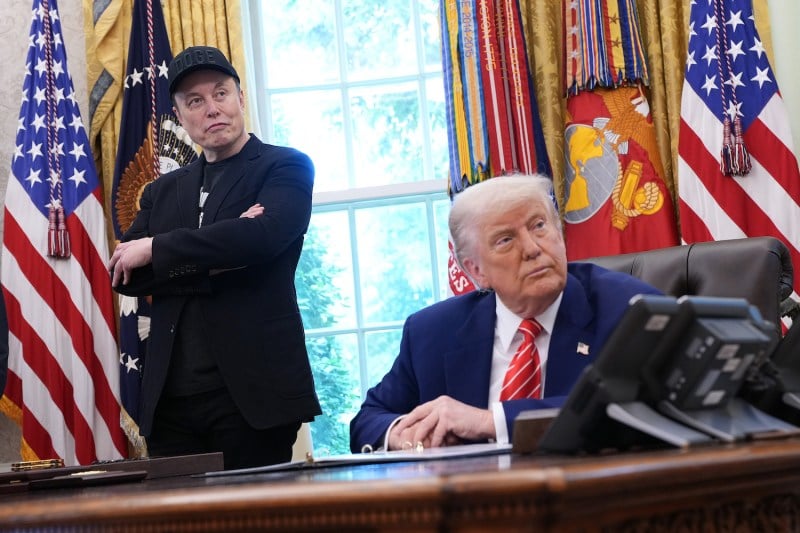The Economics of Trump’s Budget and Policy Bill

The Economics of Trump’s Budget and Policy Bill
Pushing millions off Medicaid will help offset tax cuts.
Tesla CEO Elon Musk and U.S. President Donald Trump listen to a question from reporters in the Oval Office of the White House in Washington, DC, on May 30. Kevin Dietsch/Getty Images
U.S. President Donald Trump’s tax and policy bill represents the first, and perhaps last, initiative of his second administration. At its heart, the law would extend existing tax cuts that Trump introduced in his first term while reducing spending on Medicaid. The bill has already been passed by the House of Representatives. If it’s passed by the Senate, the result would be a $2.4 trillion increase in the national debt in the coming decade and 10.9 million Americans losing their current health insurance coverage.
How do Republican populists relate to this law? How exactly do Medicaid work requirements result in less spending? And what effects will increased debt have on the United States?
U.S. President Donald Trump’s tax and policy bill represents the first, and perhaps last, initiative of his second administration. At its heart, the law would extend existing tax cuts that Trump introduced in his first term while reducing spending on Medicaid. The bill has already been passed by the House of Representatives. If it’s passed by the Senate, the result would be a $2.4 trillion increase in the national debt in the coming decade and 10.9 million Americans losing their current health insurance coverage.
How do Republican populists relate to this law? How exactly do Medicaid work requirements result in less spending? And what effects will increased debt have on the United States?
Those are just a few of the questions that came up in my recent conversation with FP economics columnist Adam Tooze on the podcast we co-host, Ones and Tooze. What follows is an excerpt, edited for length and clarity. For the full conversation, look for Ones and Tooze wherever you get your podcasts. And check out Adam’s Substack newsletter.
Cameron Abadi: How do the various factions in the Republican Party relate to this bill? Traditional Republicans have always been in support of tax cuts. But what about the new strain of populism—what is the populist position on the bill exactly?
Adam Tooze: I think observers of the American political scene see this as a defining test of the Republican Party at this moment, and it’s really a mess. It only passed the House by a wafer-thin majority, and there’s already substantial opposition announcing itself in the Senate. It’s pretty precarious. And that’s because there is a tax-cutting faction in the Republican Party, and that’s basically the line through here from 2017. But there’s also, of course, a fiscal hawk faction in the Republican Party. And this bill does not close the deficit, right? This makes the deficit way larger, and so there’s already a substantial opposition in the Senate that’s announcing itself around that. The usual suspects have come out, but Elon Musk has also gone over to that side. And Musk was widely thought of as the kingmaker in the Republican Party because of the amount of money that he can throw at even relatively small down-ticket congressional races. And Musk has declared this whole thing an abomination.
You’re asking about the populists—there are two different variants of that, if you like. One is the Steve Bannon-style, sort of dark conservative. Bannon hates this because of its fiscal implications. He has some dark fantasy of some sort of inflationary disaster in the United States. And then Sen. Josh Hawley, the kind of labor right version of the party, also just despises it because basically it’s a bunch of tax giveaways for rich people at the price of cuts to ordinary working-class Americans, which he’s realistic enough to know this bill will entail. It’s a hugely redistributive piece of legislation that shovels hundreds of thousands of dollars toward the richest Americans per household, while clawing money back from the poorest. Ultimately, the only thing that makes sense here is that the Republicans are doing it because they did it for Trump in 2017, and he wants it and he’s going to get it, and they owe loyalty to Trump, and so they’re going to deliver it.
But there’s just no enthusiasm for this big, beautiful bill. There’s no enthusiasm for it at all in the party, because this isn’t where the party’s heart and mind are at right now. And if that’s the case, then you have this surreal picture of the first months of the Trump administration in which he’s doing a tariff policy for which there’s no social constituency in the United States, right? As we’ve talked about repeatedly on the show, there isn’t a big lobby for 140 percent tariffs on China. And there doesn’t appear, even in this case, to be a massive rally of the Republican Party in favor of this legislation. So they’re doing it to preserve faith with the president’s legacy from 2017. And to glue the whole thing together—and this is the really sinister thing—Stephen Miller enters the fray, lines this up, and says, “This isn’t about tax at all. This is about giving the president the powers to engage in absolutely massive deportations of illegal immigrants from the United States, and that’s why you’ve got to vote for this. This is the most consequential piece of legislation.” And that in itself is a sign of the fragmentation in the Republican Party, because if there’s one thing they can all agree on other than loyalty to Trump, it’s hostility and xenophobia toward migrants.
CA: The tax cuts are paid primarily through Medicaid cuts, which come in the form of work requirements. How exactly do they lead to spending reductions on the scale that the bill is envisioning?
AT: Just for our non-American listeners who aren’t in the weeds of American social policy, what we’re talking about here is Medicaid, which is the safety net for lower-income Americans and families, children—not older people, that’s Medicare—that provides public support for medical treatments for the worst-off Americans. So it’s not true to say that America doesn’t have publicly provided health insurance—it does, but just in a discriminatory, means-tested mode. And this is expensive, as you’d expect. And of the $1.4 trillion in clawback, through which Republicans are trying to close the giant deficit gap they’re opening up with the tax giveaways, this makes up about, I think, $500 billion or something like that. The rest is coming from the Inflation Reduction Act (IRA) and other smaller items.
And as you’re saying, American politics doesn’t like to do direct subsidy or direct clawback. So when you’re doing the IRA under former President Joe Biden, you have tax relief mechanisms that work indirectly to stimulate green investment. And in this case, as you were saying, what they’re introducing or proposing to introduce is a series of tests of eligibility based on whether people are in work or not. And the majority of people on Medicaid already are, so roughly two-thirds are in either full-time or part-time work. The rest are, on the whole, not working because they have excessive family responsibilities or are sick. And the idea is to design a more exclusionary mechanism so as to cut down on the bill, to prevent people getting support—people who the Republicans think of as basically taking advantage of the American welfare state. Welfare in America is widely understood to be a dog-whistle term for white resentment at public support for poor people, poor Black people. And that’s what this campaign is about. And there is some experience with these kinds of efforts. At the state level, various types of test mechanisms have been introduced. And that is where these sort of cynical estimates of how far this procedural change will reduce the bill come from.
And the experience there is that a very large part of the exclusionary effect simply comes from the deterrent effect on stressed, struggling, and desperate people, of having to fill out a bunch of punitive-looking paperwork at the same moment they’re applying for support. And so whether or not they’re eligible, we see a very substantial attrition of folks out of the system as a result of the deterrent effect of this kind of paperwork. So it’s a cruel mechanism, right? It avoids political responsibility for what you’re doing. It allows the Republicans to say, “Oh no, all we’re doing is making this system do what it was intended to do,” whereas everyone actually understands that this is an effort to exclude populations from benefits through administrative mechanisms. American unemployment insurance operates in quite a similar way across many Republican states. It’s notionally there. It’s just humiliating and difficult to get, to the point where very large numbers of people who actually, desperately need the help fail to apply for it, or when they do apply, they fail to jump through all the hoops.
CA: How should we think about the effects of the increase in debt that would result from this law—both from a macroeconomic perspective and from the perspective of Americans in their daily lives?
AT: I think there are a few fairly noncontroversial claims one can make. The first would be that continuing to run truly huge deficits at a time of full employment—the sort of deficits that you would normally expect to see at the height of an economic crisis now being run in the United States routinely at full employment—what that does is keep the economy running hot. And the idea being banded around by Republicans, that somehow this big, beautiful bill is going to accelerate the U.S. economy to 3 or 4 percent growth, I think that’s nonsense because what it really does is, after all, just perpetuate the existing status quo. If they don’t pass this, a bunch of tax giveaways that were given away in 2017 are removed. And the tax rate would go up.
So what this does is continue the existing unbalanced fiscal regime in the United States, which helps run the economy hot. It helps, therefore, to cushion some of the negative effects of the tariffs on the U.S. economy, but it does so in a highly unequal way. So in the most extreme version, if you take the Stephen Miller view, this is a license for mass deportation. So that has a macroeconomic effect because what you’re basically doing is shifting the balance of power dramatically at the bottom end of the U.S. labor market. And we’re already seeing the deterrent effect. It’s underreported, I think, as a fact, but the best measure we have of illegal migration to the United States , which is encounters between the American border force and illegal migrants, has plunged to historically low levels. So if the aim of the game here is to tighten up the bottom end of the U.S. labor market, it’s quite likely to do that.
That may help lower-paid workers gain higher wages. On the demand side, however, there is an absolutely massive skew at the top end toward perpetuating huge inequality, adding pressure at the bottom end at the same time with the Medicaid cuts that we’ve been talking about. So what it will do is continue the unbalanced growth regime of the current moment, I think, where potentially there could be some bump to folks at the bottom end of the labor market. We’ve spoken at length at various points about who exactly that would be. Most likely, I would think, Latino workers already in the workforce are the people who are most likely to benefit from this curtailing of migrant work. At the top end of the income distribution, it’s going to be rich American households that continue to drive demand. Though, of course, they tend to save more of their income. So it will perpetuate this unbalanced growth model characteristic of the United States in recent times.
If you look at the debt market, where the financing of this deficit is being run—you know, I am not a debt alarmist, I don’t think that’s a helpful way of thinking about the situation—but if you are going to pump between $1.5 and $2 trillion worth of new treasuries into the debt market every year henceforth, you’re going to have to persuade investors to reallocate their portfolios to absorb that debt. The way you do that is by offering higher interest rates. And so what you would expect is that this will anchor, especially the longer-term interest rate, at a higher level. You know, we’re over 5 percent now for 30-year bonds in the United States. That’s where you would also expect to see a substantial correlation with the mortgage market.
So one of the effects you would expect, I think, is sustained upward pressure—a new plateau, if you like—in mortgage finance in the United States. And then that ripples through the entire credit system. But that is heavily mediated by the business strategies of American banks and other providers of credit. So, continued running hot, skewing in a complex social balance, and a higher long-run level of interest rates.
Cameron Abadi is a deputy editor at Foreign Policy. X: @CameronAbadi
Adam Tooze is a columnist at Foreign Policy and a history professor and the director of the European Institute at Columbia University. He is the author of Chartbook, a newsletter on economics, geopolitics, and history. X: @adam_tooze
Stories Readers Liked
In Case You Missed It
A selection of paywall-free articles

Four Explanatory Models for Trump’s Chaos
It’s clear that the second Trump administration is aiming for change—not inertia—in U.S. foreign policy.

























Join the Conversation
Commenting is a benefit of a Foreign Policy subscription.
Subscribe
Subscribe
Already a subscriber?
.
View Comments
Join the Conversation
Join the conversation on this and other recent Foreign Policy articles when you subscribe now.
Subscribe
Subscribe
Not your account?
View Comments
Join the Conversation
Please follow our comment guidelines, stay on topic, and be civil, courteous, and respectful of others’ beliefs.
View Comments
Change your username |
Log out
Change your username:
CANCEL
Confirm your username to get started.
The default username below has been generated using the first name and last initial on your FP subscriber account. Usernames may be updated at any time and must not contain inappropriate or offensive language.